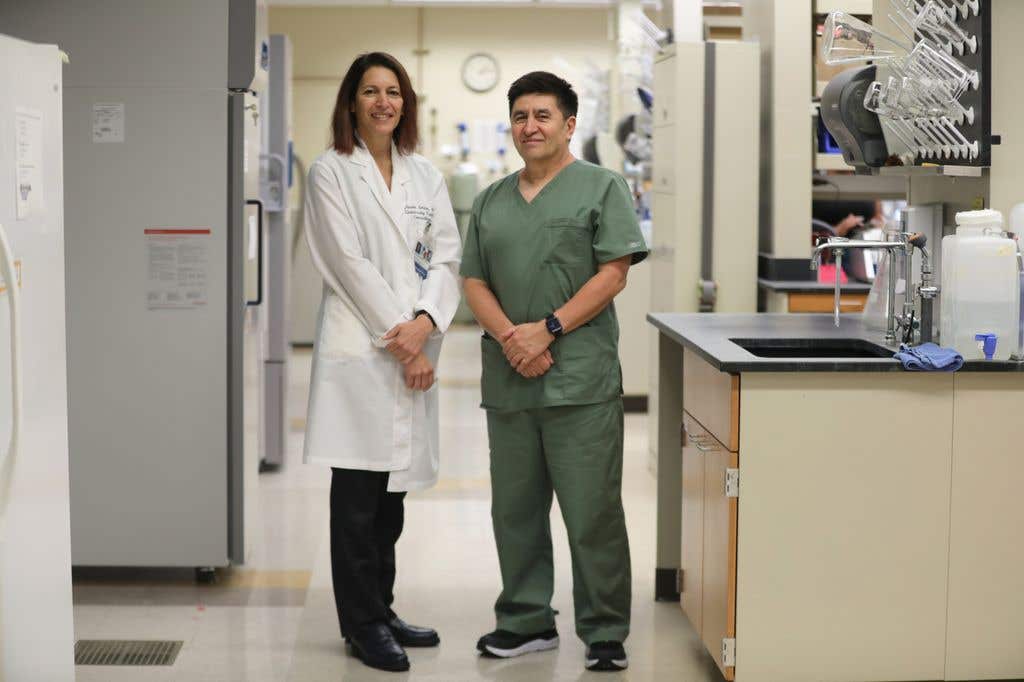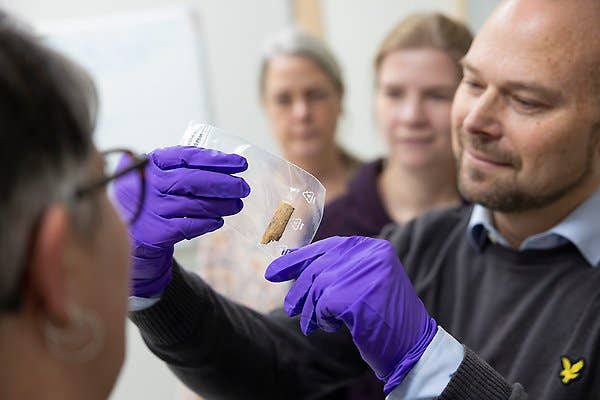Scientists develop functional eggs out of human skin cells
Scientists develop “mitomeiosis,” a hybrid cell division that could one day help treat infertility and create lab-grown eggs.

Paula Amato, M.D., professor of obstetrics and gynecology in the OHSU School of Medicine, and Shoukhrat Mitalipov, Ph.D., director of the OHSU Center for Embryonic Cell and Gene Therapy. (CREDIT: OHSU/Christine Torres Hicks)
Researchers at Oregon Health & Science University (OHSU) have developed a remarkable new way for making human body cells behave like egg cells—a technique that could change the course of the future of fertility treatment.
The team, led by reproductive biologist Shoukhrat Mitalipov, calls the procedure mitomeiosis. It borrows from two of the simplest biology processes: mitosis, which allows cells to increase in size, and meiosis, which generates sperm and eggs. This is the first instance of scientists artificially reducing the number of human body cells' chromosomes, a key step toward creating lab-grown gametes.
Translating Skin Cells into Potential Egg Cells
All normal human cells contain 46 chromosomes, in 23 sets. Eggs and sperm each contain just one set—23 unpaired chromosomes—so when they come together to create an embryo, the resulting entity will contain the full 46. Replicating that decrease in a laboratory tube has been a longstanding challenge. Scientists have struggled to reproduce meiosis, the body's natural way of halving the number of chromosomes in reproduction cells.
Instead of trying to reprogram the stem cells, OHSU scientists used a workaround based on the cloning of Dolly the sheep in 1997. They removed the nucleus from a human egg, and put the nucleus of a skin cell inside it. The egg's cytoplasm—the fluid inside it that regulates cell division—essentially took over. Without copying its DNA first, the skin cell's chromosomes were forced into a division state that was analogous to meiosis, resulting in a partial reduction of its chromosome number.
"We accomplished what was thought to be impossible," said Mitalipov, director of the OHSU Center for Embryonic Cell and Gene Therapy. "Nature gave us two types of cell division, and we just invented a third one."
Forcing Cells to Split Their Chromosomes
The research employed 270 eggs from volunteers aged 21 to 35. Once scientists combined nuclei of skin cells into empty eggs, they observed the formation of spindle fibers—the tiny machines that sever chromosomes. Within two hours, more than three-quarters of the combined cells had formed spindles, proof the egg machinery was preparing to sort out the chromosomes.
But there was a problem: the new hybrid cells were having difficulty completing the process naturally. Normally, sperm entry induces an egg to finish dividing and release half of its chromosomes into a tiny pouch called a polar body. But with this experiment, sperm itself could not trigger the hybrid cells.
To correct that, the researchers used electroporation—a quick application of electricity—and a medication named roscovitine to inactivate proteins keeping the cell "stuck" in its division state. The combination worked. About 69% of hybrid eggs were able to extrude a polar body, and more than half formed pronuclei, small spheres full of genetic material that were prepared to join with sperm. The moment sperm fertilization was added to the mixture, over three-quarters of the activated cells developed two pronuclei, the indication that they had been fertilized successfully.
Mixed Embryos Early With
After being fertilized, the embryos began to divide. About 83% of them developed to the two-cell stage, and nearly 9% developed to the blastocyst stage—a first milestone when embryos are typically transferred in IVF treatment. Success was low, but for the first time, scientists had created artificial embryos with genetic material from both a body cell and sperm.
Genetic sequencing revealed that the separation of the chromosomes far from perfect. The embryos had all 46 chromosomes in some cases, while in others, they lost or gained a few, and patches of mixed cell types were formed, referred to as mosaicism. On average, half the nuclear chromosomes were kept in the embryo, and the rest were excluded into the polar body. The separation appeared random and not based on genetics, unlike natural meiosis.
This work demonstrates that it is possible to make human body cells act somewhat like eggs," said lead author Nuria Marti Gutierrez, a staff scientist at OHSU. "Now the task is to make that reliable, so that each egg that results has the proper number of chromosomes."
A Long Road Before Clinical Use
Even with this progress, the researchers stress that the method is far from ready for medical use. Most embryos stopped developing before reaching the blastocyst stage, and many displayed chromosome errors, known as aneuploidy. “Aneuploidy is pretty common in human eggs, especially with aging,” Mitalipov noted, “so we’re not too surprised to see it here.”
The OHSU scientists figure it would take another ten years of research before this technique could potentially be tested in people and even then would depend on getting permission for a clinical trial—a giant leap in America. Even so, the stakes are compelling. The study offers an accessible window to in vitro gametogenesis (IVG), the creation of eggs or sperm in a lab, potentially allowing people who lack viable gametes—like those treated with chemotherapy—to give birth to genetically matched children.
"Along with offering hope to millions of people with infertility caused by egg or sperm deficiency," said co-author Dr. Paula Amato at OHSU's School of Medicine, "this procedure would offer the possibility for same-sex couples to have a child genetically related to both partners."
The Promise and the Questions
The method is at the cutting edge of reproductive biology, raising as much hope as consternation. In its refined state, mitomeiosis could allow researchers to create eggs from skin cells, offering hope for women of extremely advanced maternal age or with a normal inability to produce eggs. It could even allow creation of sperm or eggs from cells from the same individual, redefining genetic parenthood.
At this point, mitomeiosis is a fragile proof of concept. The process does not have the strict control of natural meiosis, and embryos that are formed would often have aberrant numbers of chromosomes. The hurdle for scientists is to maximize the way chromosomes align, pair, and divide so that each new egg cell gets the correct 23 chromosomes.
“This research is a milestone,” Mitalipov said, “but we’re only beginning to understand how to guide the process faithfully and safely.”
Practical Implications of the Research
If perfected, mitomeiosis could transform reproductive medicine. It could one day enable people who have lost fertility—through illness, aging, or treatment—to have children genetically related to them. The method could also allow same-sex couples to conceive using their own genetic material.
In addition to fertility, understanding control of chromosome division in human cells could potentially enhance knowledge of genetic disease, embryonic development, and even cancer.
The research moves scientists one step closer towards being able to produce eggs and sperm in the lab, but raises questions about the ethics of applying such technology.
Research findings are available online in the journal Nature Communications.
Related Stories
- Men's role in reproduction could soon become obsolete
- New enzyme discovery could transform male birth control
- Male embryos grow faster: Breakthrough study reveals genetic reasons why
Like these kind of feel good stories? Get The Brighter Side of News' newsletter.
Joseph Shavit
Science News Writer, Editor-At-Large and Publisher
Joseph Shavit, based in Los Angeles, is a seasoned science journalist, editor and co-founder of The Brighter Side of News, where he transforms complex discoveries into clear, engaging stories for general readers. With experience at major media groups like Times Mirror and Tribune, he writes with both authority and curiosity. His work spans astronomy, physics, quantum mechanics, climate change, artificial intelligence, health, and medicine. Known for linking breakthroughs to real-world markets, he highlights how research transitions into products and industries that shape daily life.



